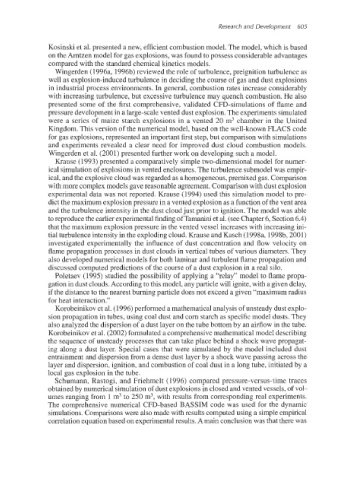Page 638 - Dust Explosions in the Process Industries
P. 638
Research and Development 605
Kosinski et al. presented a new, efficient combustionmodel. The model, which is based
on the Arntzen model for gas explosions,was found to possess considerable advantages
compared with the standard chemical kinetics models.
Wingerden (1996a, 1996b)reviewed the role of turbulence, preignition turbulence as
well as explosion-inducedturbulence in deciding the course of gas and dust explosions
in industrial process environments. In general, combustion rates increase considerably
with increasing turbulence, but excessive turbulence may quench combustion. He also
presented some of the first comprehensive, validated CFD-simulations of flame and
pressure development in a large-scalevented dust explosion.The experiments simulated
were a series of maize starch explosions in a vented 20 m3 chamber in the United
Kingdom. This version of the numerical model, based on the well-known FLACS code
for gas explosions,represented an important first step, but comparisonwith simulations
and experiments revealed a clear need for improved dust cloud combustion models.
Wingerden et al. (2001) presented further work on developing such a model.
Krause (1993) presented a comparatively simple two-dimensionalmodel for numer-
ical simulation of explosionsin vented enclosures.The turbulence submodel was empir-
ical, and the explosive cloud was regarded as a homogeneous,premixed gas. Comparison
with more complex models gave reasonableagreement. Comparison with dust explosion
experimental data was not reported. Krause (1994) used this simulation model to pre-
dict the maximum explosionpressure in a vented explosionas a function of the vent area
and the turbulence intensity in the dust cloud just prior to ignition. The model was able
to reproducethe earlier experimentalfinding of Tamaniniet al. (see Chapter 6, Section6.4)
that the maximum explosion pressure in the vented vessel increases with increasing ini-
tial turbulence intensity in the explodingcloud. Krause and Kasch (199Xa, 1998b,2001)
investigated experimentally the influence of dust concentration and flow velocity on
flame propagation processes in dust clouds in vertical tubes of various diameters. They
also developed numerical models for both laminar and turbulent flame propagation and
discussledcomputed predictions of the course of a dust explosion in a real silo.
Poletaev (1995) studied the possibility of applying a “relay” model to flame propa-
gation in dust clouds.According to this model, any particle will ignite, with a given delay,
if the distance to the nearest burning particle does not exceed a given “maximurnradius
for heat interaction.”
Morobeinikov et al~(1994) performed a mathematical analysis of unsteady dust explo-
sion propagation in tubes, using coal dust and corn starch as specific model dusts. They
also analyzed the dispersion of a dust layer on the tube bottom by an airflow in the tube.
Korobeinikovet al. (2002) formulated a comprehensivemathematicalmodel describing
the sequence of unsteady processes that can take place behind a shock wave propagat-
ing along a dust layer. Special cases that were simulated by the model included dust
entrainment and dispersion from a dense dust layer by a shock wave passing across the
layer and dispersion, ignition, and combustion of coal dust in a long tube, initiated by a
local gas explosion in the tube.
Schumann, Rastogi, and Friehmelt (1996) compared pressure-versus-time traces
obtained by numerical simulation of dust explosions in closed and vented vessels, of vol-
umes ranging from 1 m3 to 250 m3,with results from corresponding real experiments.
The comprehensive numerical CFD-based BASSIM code was used for the dynamic
simulations.Comparisons were also made with results computed using a simple empirical
correlation equation based on experimental results. A main conclusion was that there was

